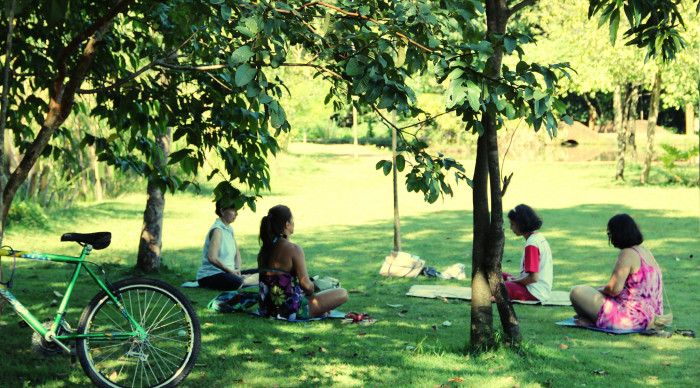A quick Google search on “how to meditate” will present you with 13.5 million websites and articles on the topic. For someone who’s just beginning a daily practice or looking to try a new technique, it’s a double-edged sword: The abundance of information available can be helpful and inspiring, but also completely overwhelming. And giving yourself a break from information overload is probably one of the reasons you want to meditate in the first place!
When I’m in need of some meditation inspiration, I find it helpful to revisit the clear, simple writings of some of my favorite spiritual teachers. Their advice is a distillation of many years of tradition and practice. And since their words of wisdom arise from the same open state of awareness that we catch glimpses of in meditation, they can help guide us to that place of presence within.
1. Thich Nhat Hanh
Technique: Mindfulness of the body and breath
In The Blooming of a Lotus: Guided Meditation for Achieving the Miracle of Mindfulness, Thich Nhat Hanh offers the following phrases which, repeated silently to yourself, serve as a gentle anchor for the mind. You can practice this exercise — letting your mind rest on the full phrases or one-word abbreviations — anytime, anywhere, with eyes open or closed.
“Breathing in, I know I am breathing in. — In
Breathing out, I know I am breathing out. — Out
Breathing in, my breath grows deep. — Deep
Breathing out, my breath goes slowly. — Slow
Breathing in, I feel calm. — Calm
Breathing out, I feel ease. — Ease
Breathing in, I smile. — Smile
Breathing out, I release. — Release
Dwelling in the present moment, — Present moment
I know it is a wonderful moment. — Wonderful moment
The first stage is designed to bring body and mind back into oneness and at the same time to help bring us back to the present moment, to connect us with the miracle of life now occurring.
If we can breathe in this spirit for two or three minutes, our breathing will quite naturally become light, leisurely, gentler, slower, and deeper, and naturally we shall feel much more at ease in body as well as in mind.” (Exercise Three, Joy of Meditation as Nourishment)
2. Pema Chödrön
Technique: Labeling “thinking”
So here we are practicing mindfulness of the body and breath, and what inevitably happens? Our thoughts begin to interrupt, of course. We all experience monkey mind, the haphazard jumping from one random thought to another, like a monkey swinging from branch to branch. It can be a frustrating experience when your mind really needs a rest.
But fluctuations of the mind are a fact of human existence. Instead of getting frustrated or beating yourself up, you can think of each time you notice the mind wandering as an opportunity to practice coming back to center (whether the object of your concentration is the breath, a focal point in the body, or otherwise).
In Start Where You Are: A Guide to Compassionate Living, Pema Chödrön offers a technique to help us lighten up and be gentle with ourselves when the mind wanders:
“… Being with the breath is only part of the technique. These thoughts that run through our minds continually are the other part. We sit here talking to ourselves. The instruction is that when you realize you’ve been thinking you label it “thinking.” When your mind wanders off, you say to yourself, “Thinking.”
Regard the thoughts as bubbles and the labeling like touching them with a feather. There’s just this light touch – “Thinking” – and they dissolve back into the space.
Don’t worry about achieving. Don’t worry about perfection. Just be there each moment as best you can. When you realize you’ve wandered off again, simply very lightly acknowledge that. This light touch is the golden key to reuniting with our openness.”
3. Eckhart Tolle
Technique: Noticing sounds, paying attention to silence
In addition to our stream of thoughts, sounds in the immediate environment are another common distraction that pops up in meditation. However, as Eckhart Tolle describes in Stillness Speaks and The Power of Now, noticing sounds as they enter your awareness also helps you become aware of the silence that surrounds and lies beneath every sound. And paying attention to silence, whether you’re in a noisy environment or a quiet one, enables us to get in touch with the stillness within ourselves.
“Whenever there is some silence around you – listen to it. That means just notice it. Pay attention to it. Listening to silence awakens the dimension of stillness within yourself, because it is only through stillness that you can be aware of silence. See that in the moment of noticing the silence around you, you are not thinking. You are aware, but not thinking.
Silence is helpful, but you don’t need it in order to find stillness. Even when there is noise, you can be aware of the stillness underneath the noise, of the space in which the noise arises … Any disturbing noise can be as helpful as silence. How? By dropping your inner resistance to the noise, by allowing it to be as it is, this acceptance also takes you into that realm of inner peace that is stillness.”
Have you tried any of these techniques? Feel free to share your experiences in the comments.
Also by Annika: Why It’s Good to Be Sad Sometimes
3 Free Meditation Resources to Grow Your Practice
5 Yoga Exercises to Correct Rounded Shoulders
Get more like this–sign up for our newsletter for exclusive inspirational content!
Photo: Victor Camilo via Flickr





